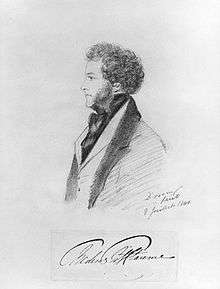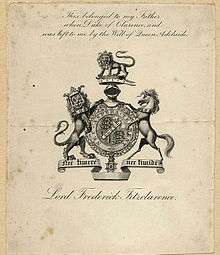Lord Frederick FitzClarence
| Lord Frederick FitzClarence | |
|---|---|
 Lord Frederick FitzClarence | |
| Born | 9 December 1799 |
| Died | 30 October 1854 (aged 54) |
| Allegiance |
|
| Service/branch |
|
| Years of service | 1814–1854 |
| Rank | Lieutenant-General |
| Commands held | Bombay Army |
| Awards | Knight Grand Cross of the Royal Guelphic Order |
Lieutenant-General Lord Frederick FitzClarence, GCH (9 December 1799 – 30 October 1854) was a British Army officer as well as being the illegitimate third son of King William IV and his mistress, Dorothea Jordan.
Military career
FitzClarence was commissioned as an officer in the British Army in 1814.[1] While a captain in the Coldstream Guards, FitzClarence commanded a small detachment of Guards to act in support of the police with the arrest of the Cato Street conspirators in 1820.[1] The arrest was not straightforward, and a scuffle ensued.[2] The Naval and Military Gazette (May 1845) identified Sgt James Graham as the man who saved FitzClarence's life.[3]
Frederick FitzClarence gained the rank of Colonel in the service of the 36th (Herefordshire) Regiment of Foot.[1] On 24 May 1831 he was granted the rank of a marquess' younger son.[1] Having been invested as a Knight Grand Cross of the Royal Guelphic Order (G.C.H.) that same year, he became Lieutenant-Governor of Portsmouth and General Officer Commanding South-West District in 1847[4] and then Commander-in-Chief of the Bombay Army in 1852.[5] He died in office in October 1854.[1]

Family
On 19 May 1821, he married Lady Augusta Boyle (d. 28 July 1876), the eldest daughter of the 4th Earl of Glasgow. They had two children:
- Augusta FitzClarence (December 1824 – 18 October 1865)
- William FitzClarence (b. & d. 1827)
Ancestry
| Ancestors of Lord Frederick FitzClarence | ||||||||||||||||||||||||||||||||||||||||||||||||||||||||||||||||||||||||||||||||||||||||||||||||||||||||||||||||||||||||||||||||||||||||||||||||||||||||||||||||||||||||||||||||||||||||||||||||||||||||||||||||||||||||||||||||||||||||||||||||||||||||||||||||||||||||||||||||||||||||||||||||||||||||||||||||||||||||||||||||||||||||||||||||||||||||||||||||||||||||||||||||||||||||||||||||||||||||||||||||||||||||||||||
|---|---|---|---|---|---|---|---|---|---|---|---|---|---|---|---|---|---|---|---|---|---|---|---|---|---|---|---|---|---|---|---|---|---|---|---|---|---|---|---|---|---|---|---|---|---|---|---|---|---|---|---|---|---|---|---|---|---|---|---|---|---|---|---|---|---|---|---|---|---|---|---|---|---|---|---|---|---|---|---|---|---|---|---|---|---|---|---|---|---|---|---|---|---|---|---|---|---|---|---|---|---|---|---|---|---|---|---|---|---|---|---|---|---|---|---|---|---|---|---|---|---|---|---|---|---|---|---|---|---|---|---|---|---|---|---|---|---|---|---|---|---|---|---|---|---|---|---|---|---|---|---|---|---|---|---|---|---|---|---|---|---|---|---|---|---|---|---|---|---|---|---|---|---|---|---|---|---|---|---|---|---|---|---|---|---|---|---|---|---|---|---|---|---|---|---|---|---|---|---|---|---|---|---|---|---|---|---|---|---|---|---|---|---|---|---|---|---|---|---|---|---|---|---|---|---|---|---|---|---|---|---|---|---|---|---|---|---|---|---|---|---|---|---|---|---|---|---|---|---|---|---|---|---|---|---|---|---|---|---|---|---|---|---|---|---|---|---|---|---|---|---|---|---|---|---|---|---|---|---|---|---|---|---|---|---|---|---|---|---|---|---|---|---|---|---|---|---|---|---|---|---|---|---|---|---|---|---|---|---|---|---|---|---|---|---|---|---|---|---|---|---|---|---|---|---|---|---|---|---|---|---|---|---|---|---|---|---|---|---|---|---|---|---|---|---|---|---|---|---|---|---|---|---|---|---|---|---|---|---|---|---|---|---|---|---|---|---|---|---|---|---|---|---|---|---|---|---|---|---|---|---|---|---|---|---|---|---|---|---|---|---|---|---|---|---|---|---|---|---|---|---|---|---|---|---|---|---|---|---|---|---|---|---|---|
| ||||||||||||||||||||||||||||||||||||||||||||||||||||||||||||||||||||||||||||||||||||||||||||||||||||||||||||||||||||||||||||||||||||||||||||||||||||||||||||||||||||||||||||||||||||||||||||||||||||||||||||||||||||||||||||||||||||||||||||||||||||||||||||||||||||||||||||||||||||||||||||||||||||||||||||||||||||||||||||||||||||||||||||||||||||||||||||||||||||||||||||||||||||||||||||||||||||||||||||||||||||||||||||||
References
- 1 2 3 4 5 Lord Frederick FitzClarence obituary The Gentleman's Magazine, 1855, p.304
- ↑ Morning Chronicle, Thursday, 24 February 1820, as replicated on A Web of English History
- ↑ Chichester, H.M.; "Graham, James (1791–1845)", (rev. James Lunt), Oxford Dictionary of National Biography, Oxford University Press, 2004
- ↑ "Final resting place for two horses". Portsmouth News. 21 April 2013. Retrieved 4 December 2014.
- ↑ The India List and India Office List
| Military offices | ||
|---|---|---|
| Preceded by Sir Hercules Pakenham |
GOC South-West District 1847–1851 |
Succeeded by Sir George D'Aguilar |
| Preceded by Sir John Grey |
C-in-C, Bombay Army 1852–1854 |
Succeeded by Sir Henry Somerset |
| Preceded by Sir Roger Hale Sheaffe, Bt |
Colonel of the 36th (Herefordshire) Regiment of Foot 1751–1754 |
Succeeded by William Henry Scott |
| Masonic offices | ||
| Preceded by The Earl of Rothes |
Grand Master of the Grand Lodge of Scotland 1841–1843 |
Succeeded by Lord Glenlyon |
| Honorary titles | ||
| Preceded by The Earl of Munster |
Lieutenant of the Tower of London 1833 |
Succeeded by John Sulivan Wood |